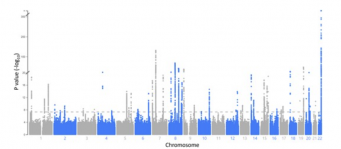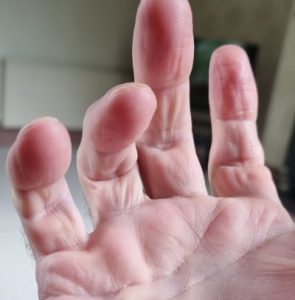What I Didn’t Know
I had thought that Dupuytrens was a condition found in older populations, had no idea if there was a difference between males and females, but had heard that it was more prevalent in Northern European populations, hence it was known as the Viking Disease or Viking Hand. A bit of reading around scientific publications has improved my knowledge considerably. This post attempts to summarise some of the key points I’ve learnt. The image at the top of this post depicts some data froma genome wide association study published by Chen et al 2020.
Age:
Age is definitely a key factor in Dupuytren’s development but it is not exclusive to anyage group. I was surprised, when discussing my hands with a physiotherapist, to learn that she had treated patients in their late 20’s/early 30’s. My age group, in the mid 60’s is the age with the highest disease onset but the condition has been identified in teenage patients and, very rarely, even younger.
Sex:
Studies again have shown that both males and females can develop Dupytren’s. However, the bad news for us men is that we are four to five times more likely to suffer than women
Age and sex, some data:
A nice summary of age and sex can be found in a paper by Becker and co-workers published in 2015. This examined the age at first surgery (not first diagnosis) of 801 individuals. Their findings are summarised in the table below.

Summarising Age and Sex:
The youngest age group identified was in the 29-39 age group at the time of first surgery, the eldest group being the over 80’s. Note this is the age at first surgery and does not mention age at first diagnosis. In all age groups men are far more prevalent than women, overall the ratio is 4.6:1. The last two columns also show that there is often a family history of the disease, around 40% of all cases.
The youngest sufferer I have come across was identified at the age of 6 months old had surgery at 10 months (Bebbington and Savage 2005). Such cases are fortunately very rare.
Race:
According to the UK National Institute of Health and Care Excellence (NICE 2025) the overall prevalence of the disease in the UK is about 4%, rising to about 20% in those aged over 65 years. In the UK. In total this means that more than 2 million people in the UK are thought to have Dupuytren’s disease. Also, in most studies, individuals in northern Scotland, Iceland, and Norway have the highest prevalence of Dupuytren’s contracture.
In Europe, the highest reported incidence of Dupuytrens was in Bosnia (now Bosnia Herzegovena). Asian and African populations have very low incidence but rates in the USA, Canada and Australasia are more like European populations. No doubt reflecting the origins of much of their current populations (Hindocha et al 2009).
Recently, genome wide association studies (GWAS) have linked these geographical variations to Neanderthal inheritance. Apparently up to 2% of our genomes comes from our ancestors interbreeding with the now extinct Neanderthal hominids (Ågren et al 2023). [My speculation is that this was related to the discovery of alcohol from natural fermentation processes!].
Age, sex and Race:
Overall age, sex and race clealry have a lot to do with Dupuytren’s. However there may be other factors at play which will be the subject of a future post.
References:
Ågren R, Patil S, Zhou X, Kristoffer Sahlholm K, Pääbo S and Zeberg H, Major Genetic Risk Factors for Dupuytren’s Disease Are Inherited From Neandertals, Molecular Biology and Evolution, 2023, 40 (6), msad130, https://doi.org/10.1093/molbev/msad130
Bebbington A, Savage R. Dupuytren’s disease in an infant. J Bone Joint Surg Br. 2005 Jan;87(1):111-3. PMID: 15686249.
Becker K, Tinschert S, Lienert A, Bleuler PE, Staub F, Meinel A, Rößler J, Wach W, Hoffmann R, Kühnel F, Damert HG, Nick HE, Spicher R, Lenze W, Langer M, Nürnberg P, Hennies HC. The importance of genetic susceptibility in Dupuytren’s disease. Clin Genet. 2015 May;87(5):483-7. doi: 10.1111/cge.12410.
Chen L, Wolf AB, Fu W, Li L and Akey JM. Identifying and interpreting apparent Neanderthal ancestry in African individuals. Cell 2020; 180(4): 677-687. DOI: 10.1016/j.cell.2020.01.012
Hindocha S, McGrouther DA, Bayat A. Epidemiological evaluation of Dupuytren’s disease incidence and prevalence rates in relation to etiology. Hand (N Y). 2009 Sep;4(3):256-69. doi: 10.1007/s11552-008-9160-9.
NICE 2025 available at https://cks.nice.org.uk/topics/dupuytrens-disease/background-information/prevalence/ (Accessed 21/07/2025)



